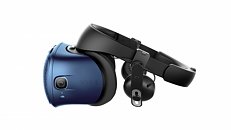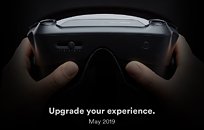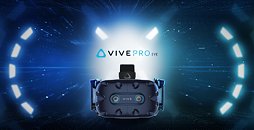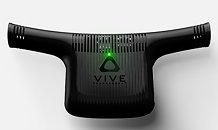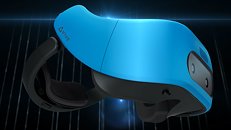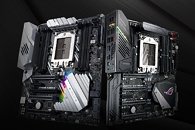Apr 16th, 2025 09:18 EDT
change timezone
Latest GPU Drivers
New Forum Posts
- Last game you purchased? (772)
- Help me identify Chip of this DDR4 RAM (20)
- 5070ti overclock...what are your settings? (5)
- Windows 11 fresh install to do list (23)
- How to relubricate a fan and/or service a troublesome/noisy fan. (229)
- GPU Memory Temprature is always high (16)
- Help For XFX RX 590 GME Chinese - Vbios (4)
- PCGH: "hidden site" to see total money spend on steam (3)
- Share your AIDA 64 cache and memory benchmark here (3053)
- NVFlash for RTX 50 Series (Blackwell) (0)
Popular Reviews
- G.SKILL Trident Z5 NEO RGB DDR5-6000 32 GB CL26 Review - AMD EXPO
- ASUS GeForce RTX 5080 TUF OC Review
- DAREU A950 Wing Review
- The Last Of Us Part 2 Performance Benchmark Review - 30 GPUs Compared
- Sapphire Radeon RX 9070 XT Pulse Review
- Sapphire Radeon RX 9070 XT Nitro+ Review - Beating NVIDIA
- Upcoming Hardware Launches 2025 (Updated Apr 2025)
- Thermaltake TR100 Review
- Zotac GeForce RTX 5070 Ti Amp Extreme Review
- TerraMaster F8 SSD Plus Review - Compact and quiet
Controversial News Posts
- NVIDIA GeForce RTX 5060 Ti 16 GB SKU Likely Launching at $499, According to Supply Chain Leak (182)
- NVIDIA Sends MSRP Numbers to Partners: GeForce RTX 5060 Ti 8 GB at $379, RTX 5060 Ti 16 GB at $429 (124)
- Nintendo Confirms That Switch 2 Joy-Cons Will Not Utilize Hall Effect Stick Technology (105)
- Over 200,000 Sold Radeon RX 9070 and RX 9070 XT GPUs? AMD Says No Number was Given (100)
- Nintendo Switch 2 Launches June 5 at $449.99 with New Hardware and Games (99)
- Sony Increases the PS5 Pricing in EMEA and ANZ by Around 25 Percent (85)
- NVIDIA PhysX and Flow Made Fully Open-Source (77)
- NVIDIA Pushes GeForce RTX 5060 Ti Launch to Mid-April, RTX 5060 to May (77)
News Posts matching #Vive
Return to Keyword Browsing
HTC VIVE Breaks new Ground with Launch of Portable VIVE Flow Immersive Glasses
HTC VIVE today announced VIVE Flow, a compact, lightweight immersive glasses device that transports its wearers wherever they want or need to be - anytime, anywhere. "With VIVE Flow, HTC is taking technology in a new direction, focusing not on what we do, but on how we feel. Maintaining our wellness has come to the forefront in the last few years, with so many millions feeling stressed every day, so it has never been more important to take time out to calm our minds, and VIVE Flow provides the perfect opportunity to escape our four walls and immerse ourselves in our ideal ambience," said Cher Wang, Chairwoman and CEO of HTC. "Meditation, gentle stretches, brain training, streaming our favorite shows or even meeting friends or coworkers in VR with VIVE Sync can all be enhanced by a device light and compact enough to fit in our pocket. VIVE Flow represents the next evolution of technology, as we take a more holistic view of how we can make life better."
"Relaxation means different things to different people," said Nanea Reeves, CEO of leading XR wellness service TRIPP. "It's important to find your own version of zen, whether that means meditating, watching videos, or playing games. The fact that HTC gets it, that we can use VR in these ways that can benefit peoples' emotional and mental well-being is something that I personally am very excited about as is our entire team at TRIPP."
"Relaxation means different things to different people," said Nanea Reeves, CEO of leading XR wellness service TRIPP. "It's important to find your own version of zen, whether that means meditating, watching videos, or playing games. The fact that HTC gets it, that we can use VR in these ways that can benefit peoples' emotional and mental well-being is something that I personally am very excited about as is our entire team at TRIPP."

Upcoming HTC Vive Flow VR Headset Leaks Ahead of Launch
HTC is said to be launching a new VR headset within the next couple days and thanks to @evleaks we now have a pretty good idea as to what to expect. Although we don't know the actual hardware specifications, it's supposed to be a stand-alone headset that doesn't require a PC to work, although the massive leak that appears to be presentation slides, does give away quite a lot of details.
For starters, there are details explaining that the Vive Flow as the new headset is called, can be paired over Bluetooth with smartphones and you can use the phone as a controller. It'll also be possible to stream content to the Vive Flow via Miracast from smartphones and possibly also other sources. The headset appears to be powered via a USB-C cable, although the pictures are ambiguous, as the Vive Flow is sometimes wired to a phone, but most of the time it doesn't appear to be connected to anything, not even a power source.
For starters, there are details explaining that the Vive Flow as the new headset is called, can be paired over Bluetooth with smartphones and you can use the phone as a controller. It'll also be possible to stream content to the Vive Flow via Miracast from smartphones and possibly also other sources. The headset appears to be powered via a USB-C cable, although the pictures are ambiguous, as the Vive Flow is sometimes wired to a phone, but most of the time it doesn't appear to be connected to anything, not even a power source.

VIVE Focus Plus Gains Major Enhancements For Premium Enterprise VR
HTC VIVE, the leader in premium virtual reality (VR), announced today a host of new and enhanced capabilities available now for the VIVE Focus Plus, the all-in-one headset designed with the enterprise in mind. In the biggest update since the headset came to market in 2019, the features rolled out today specifically address the key operational and security concerns of businesses worldwide in deploying VR solutions.
Notably, the support of device management solutions by VMware and MobileIron enables organizations to remotely manage devices, applications and settings, and use existing licenses—or obtain them directly—with no middle-man applications or portals required. Users can also connect to corporate networks remotely using built-in VPN, or stay offline if needed, to comply with security regulations.
Notably, the support of device management solutions by VMware and MobileIron enables organizations to remotely manage devices, applications and settings, and use existing licenses—or obtain them directly—with no middle-man applications or portals required. Users can also connect to corporate networks remotely using built-in VPN, or stay offline if needed, to comply with security regulations.

HTC Vive Launches VIVE XR Suite
HTC VIVE, a global leader in innovative technology, today officially announces it will enter the cloud software business with the VIVE XR Suite offering at its hybrid event, "Journey into the Next Normal", which took place physically in Shanghai and online through the Engage virtual events platform. Comprised of five separate applications covering remote collaboration, productivity, events, social and culture, the VIVE XR Suite gives users the tools they need to overcome the new challenges faced while working and living in a socially distant world. The VIVE XR Suite is targeted to launch in Q3 2020 in China, with additional regions to follow throughout the year.
The VIVE XR Suite is comprised of 5 major applications (VIVE Sync, VIVE Sessions, VIVE Campus, VIVE Social, and VIVE Museum) to meet the daily needs of the users to overcome the new challenges faced by users around the world who are working, learning and living remotely. Although it is called an XR Suite, it is important to note that this software is not dependent on VR/AR devices to function. All the applications will function on existing PCs/laptops and some apps will even support modern smartphones, but for a superior immersive experience, PC VR or standalone VR devices would be recommended. Users will be able to login to all apps in the suite using a single account and across various devices they own. This integrated application bundle which is created in partnership with the leading software companies in their respective areas will provide a seamless experience for the consumer and business user. The CEO's of all the software partners in the VIVE XR Suite (Immersive VR Education, VirBELA, VRChat, and Museum of Other Realities) attended the event live via video and within VR in avatar form.
The VIVE XR Suite is comprised of 5 major applications (VIVE Sync, VIVE Sessions, VIVE Campus, VIVE Social, and VIVE Museum) to meet the daily needs of the users to overcome the new challenges faced by users around the world who are working, learning and living remotely. Although it is called an XR Suite, it is important to note that this software is not dependent on VR/AR devices to function. All the applications will function on existing PCs/laptops and some apps will even support modern smartphones, but for a superior immersive experience, PC VR or standalone VR devices would be recommended. Users will be able to login to all apps in the suite using a single account and across various devices they own. This integrated application bundle which is created in partnership with the leading software companies in their respective areas will provide a seamless experience for the consumer and business user. The CEO's of all the software partners in the VIVE XR Suite (Immersive VR Education, VirBELA, VRChat, and Museum of Other Realities) attended the event live via video and within VR in avatar form.

HTC's Next VR Product, the Vive Cosmos, to be Available for $699
HTC has invested heavily into its VR place in the market, with the company being one of the most prolific in both exploring the market (that's till a relative niche) and developing improvements on their products. The new Vive Cosmos VR headset is another take on the VR world, one with modularity in mind and set with better technical specification than the original Vive - while undercutting the Vive Pro by $200, down to $699.
The Vive Cosmos features a higher 2880 x 1700p combined lens resolution (90Hz refresh rate), up from the original Vive's 2160 x 1200p. Usability improvements include the faceplate, which is now of a flip-up design that keeps the headset resting on your head when you need to actually take a look at the world around you (or your pet, or your staring significant other and the cold food that lays on the table by now).
The Vive Cosmos features a higher 2880 x 1700p combined lens resolution (90Hz refresh rate), up from the original Vive's 2160 x 1200p. Usability improvements include the faceplate, which is now of a flip-up design that keeps the headset resting on your head when you need to actually take a look at the world around you (or your pet, or your staring significant other and the cold food that lays on the table by now).
Valve Officially Launches the Valve Index VR HMD, Full Kit Preorder Up for $999
We knew this was coming, given Valve's own teaser confirmation from March, and then a faux pas that resulted in an incomplete Steam store page ending up public for a short time. Valve had promised more details would come in May, and here we are with a lot of information available about the Valve Index headset, the controllers, the base stations, as well as retail pricing + availability.
Name aside, the Valve Index specs that leaked before end up holding true with the retail product. The headset uses dual 1440x1600 RGB LCDs which Valve claims helps provide 50% more subpixels relative to an OLED display. This in turn should result in higher effective sharpness for the same rendering horsepower, and is further accentuated via a 3x better fill factor to mitigate the dreaded screen-door effect. The headset runs at 120 Hz with full backwards compatibility to 90 Hz to work with VR titles built around that specification and, more interestingly, also supports an experimental 144 Hz mode. PC gamers have long known the benefits of higher framerates, and this is especially valid with VR, but time will tell how the rest of the ecosystem works around this. Equally important to VR gaming is the illumination period, which allows on-screen imagery to remain sharp while you are in motion just as well as when at rest. Valve claims up to a 5x reduction here, with a rated illumination period of 0.33 to 0.53 ms depending on the real time framerate. More to see past the break, so be sure to do so if this interests you!
Name aside, the Valve Index specs that leaked before end up holding true with the retail product. The headset uses dual 1440x1600 RGB LCDs which Valve claims helps provide 50% more subpixels relative to an OLED display. This in turn should result in higher effective sharpness for the same rendering horsepower, and is further accentuated via a 3x better fill factor to mitigate the dreaded screen-door effect. The headset runs at 120 Hz with full backwards compatibility to 90 Hz to work with VR titles built around that specification and, more interestingly, also supports an experimental 144 Hz mode. PC gamers have long known the benefits of higher framerates, and this is especially valid with VR, but time will tell how the rest of the ecosystem works around this. Equally important to VR gaming is the illumination period, which allows on-screen imagery to remain sharp while you are in motion just as well as when at rest. Valve claims up to a 5x reduction here, with a rated illumination period of 0.33 to 0.53 ms depending on the real time framerate. More to see past the break, so be sure to do so if this interests you!

Intel, AMD, and HTC Partner to Resolve Vive Wireless Adapter Compatibility Issue with Ryzen Processors
The headline of this post makes it seem a touch more innocuous than the story may lead to, at least if you believe the rumor mills abound. There has been an ongoing issue with AMD systems using Ryzen CPUs and the HTC Vive wireless adapter (powered by Intel WiGig) to where the systems have frozen or even had a BSOD. HTC acknowledged this as early as Nov, 2018, noting that they have seen this with a subset of Ryzen-based motherboards when the PCIe wireless adapter is installed and running. It took until last week to get a solution of sorts, and unfortunately reports from users indicate this is not a true fix for everyone.
The hotfix update 1.20190410.0 was made available April 25 to attempt to combat this issue, which was garnering a lot of attention in the VR-community on whether there was more Intel could be doing to help AMD customers. This hotfix update is available automatically once an end user with the Vive wireless adapter checks for an update, and HTC acknowledge that they continue to test this, as well as partner with Intel and AMD to help resolve this once and for all. In the meantime, users report mixed success to date, including some we know personally as well, and it remains a thorn in the side of wireless VR to get to the PC successfully.
The hotfix update 1.20190410.0 was made available April 25 to attempt to combat this issue, which was garnering a lot of attention in the VR-community on whether there was more Intel could be doing to help AMD customers. This hotfix update is available automatically once an end user with the Vive wireless adapter checks for an update, and HTC acknowledge that they continue to test this, as well as partner with Intel and AMD to help resolve this once and for all. In the meantime, users report mixed success to date, including some we know personally as well, and it remains a thorn in the side of wireless VR to get to the PC successfully.

Valve Index VR HMD Details Leak Via Premature Store Page Release, Ships June 2019
When we first covered Valve's own teaser about their first-party VR hardware ecosystem under the Valve Index moniker, we were not expecting to hear much more until May. Thanks to an error on their part, product pages for the headset, base stands, and controllers were all published prematurely on Steam for a few hours yesterday, and that was enough time for all the information to be saved online by others. The product pages were not complete, and lacked details that we expect to get sooner than later, but Valve has since confirmed that all information inadvertently leaked are accurate and we now more about the retail package now.
To begin with, May 1 is targeted as the official announcement date which will also bring with it pre-order options for those going this route in PC VR. The complete package will contain the headset itself with integrated headphones, of which we have a better render available now as seen below, a tether cable using DisplayPort 1.2 and USB 3.1 Gen 1 connections (and not the VirtualLink standard we were hoping to see), a region-specific power adapter and plug(s), and two face gaskets (narrow and wide). Interestingly the now-renamed Index Controllers are not included and are an optional, separate purchase. This is also the case with the Index base stations, which all leads us to assume that existing HTC Vive controllers and base stations will be compatible with the headset, or there will be another, more complete package to choose from. No pricing information available yet, and Valve says they are still finalizing this as well as actual shipping detail- with an aim to hit it in June.
To begin with, May 1 is targeted as the official announcement date which will also bring with it pre-order options for those going this route in PC VR. The complete package will contain the headset itself with integrated headphones, of which we have a better render available now as seen below, a tether cable using DisplayPort 1.2 and USB 3.1 Gen 1 connections (and not the VirtualLink standard we were hoping to see), a region-specific power adapter and plug(s), and two face gaskets (narrow and wide). Interestingly the now-renamed Index Controllers are not included and are an optional, separate purchase. This is also the case with the Index base stations, which all leads us to assume that existing HTC Vive controllers and base stations will be compatible with the headset, or there will be another, more complete package to choose from. No pricing information available yet, and Valve says they are still finalizing this as well as actual shipping detail- with an aim to hit it in June.

Valve Confirms First-Party VR Headset Titled Valve Index, Launches May 2019
PAX East 2019 brought with it some exciting news, and the world of virtual reality no doubt sees this news as the biggest in quite some time. Valve has finally made good on their promises from yesteryear, bringing in personnel to work on both the hardware and software side of the VR market. We first saw a hint of this via a prototype VR HMD late last year, with leaked specs confirming it was Valve's own design going beyond the established competition at the time from HTC Vive and Oculus. Since then, the Vive Pro has come out with an even higher-end version using eye-tracking to target prosumers initially, and also showcasing foveated rendering that will no doubt herald VR getting more mainstream and allowing for a higher graphical fidelity as well.
The so-called Valve Index has been listed on Steam now, with no other information to see than from the image below. We know it is coming in a couple of months, perhaps even during Computex although it is unlikely. It certainly looks similar to the prototype HMD, and presumably retains the 135° field-of-view and 2,880 x 1,600 total resolution. No mention of the Steam Knuckles controller here, but that is no surprise for a teaser. What we can tell is the headset has a physical slider, presumably to assist with pupillary distance calibration, as well as fairly large lenses that extend outwards which may assist with IR-based tracking. There is no mention of HTC anywhere here, and it would be right up Valve's alley to introduce this at a relatively affordable price point to then make up on software and distribution (savings via Steam) instead. Perhaps we will see the long-rumored Half Life VR as a launch title? Time will tell, and this may well be the big boost to gaming VR that is sorely needed.
The so-called Valve Index has been listed on Steam now, with no other information to see than from the image below. We know it is coming in a couple of months, perhaps even during Computex although it is unlikely. It certainly looks similar to the prototype HMD, and presumably retains the 135° field-of-view and 2,880 x 1,600 total resolution. No mention of the Steam Knuckles controller here, but that is no surprise for a teaser. What we can tell is the headset has a physical slider, presumably to assist with pupillary distance calibration, as well as fairly large lenses that extend outwards which may assist with IR-based tracking. There is no mention of HTC anywhere here, and it would be right up Valve's alley to introduce this at a relatively affordable price point to then make up on software and distribution (savings via Steam) instead. Perhaps we will see the long-rumored Half Life VR as a launch title? Time will tell, and this may well be the big boost to gaming VR that is sorely needed.

HTC Vive Pro Eye: Hands On with Hardware and Software
The Vive Cosmos was not the only major announcement coming out of HTC's Vive business unit at CES this year. While that has massive mainstream appeal, the company was quick to let us know that it was still to early to comment further than what has already been covered in the aforelinked news post. Instead, they invited us to their suite to take a closer look at the Vive Pro Eye- one of the few things that really stood out for us at the trade show.
The Vive Pro Eye is, as the name would suggest, a new SKU with integrated eye tracking in the Vive Pro HMD. Working together with Tobii, the Vive Pro Eye allows for a more natural control mechanism within VR via eye controls, which in turn means a revamped menu navigation system is possible. This allows for increased accessibility to end users with disability, more optimization on VR performance, and detailed analysis of VR experiences for both the client and the businesses alike. Read past the break for a breakdown of our experience with the Vive Pro Eye, and the various demos on hand to showcase the feature.
The Vive Pro Eye is, as the name would suggest, a new SKU with integrated eye tracking in the Vive Pro HMD. Working together with Tobii, the Vive Pro Eye allows for a more natural control mechanism within VR via eye controls, which in turn means a revamped menu navigation system is possible. This allows for increased accessibility to end users with disability, more optimization on VR performance, and detailed analysis of VR experiences for both the client and the businesses alike. Read past the break for a breakdown of our experience with the Vive Pro Eye, and the various demos on hand to showcase the feature.

HTC Announces the Vive Cosmos Stand-Alone(ish) VR Headset at CES 2019
The pace of innovation can't stand still, and if there's one space that needs cost-cutting and new product injection to increase its install base is the VR ecosystem. HTC took to CES 2019 to reveal their new take on the VR, a semi-portable VR headset that has been designed not only for room-scale VR, but also for home use and, cryptically, on-the-go (holy moly, the headset flips up towards your forehead!).
Apparently, the Cosmos will have the ability to be powered by your smartphone and perhaps other devices - not all that surprising when you think of the RAM and computing power that it holds right in the palm of your hands (I'll say. My smartphone is a much better performer than my work PC...). And HTC says the Cosmos will be their sharpest VR headset ever - which should mean that it should feature higher resolution than the Vive Pro's 2880×1600 (1440×1600 per eye) display. A smartphone would likely only be able to power some sort of augmented reality graphics on that resolution, though - but I might be wrong.
Apparently, the Cosmos will have the ability to be powered by your smartphone and perhaps other devices - not all that surprising when you think of the RAM and computing power that it holds right in the palm of your hands (I'll say. My smartphone is a much better performer than my work PC...). And HTC says the Cosmos will be their sharpest VR headset ever - which should mean that it should feature higher resolution than the Vive Pro's 2880×1600 (1440×1600 per eye) display. A smartphone would likely only be able to power some sort of augmented reality graphics on that resolution, though - but I might be wrong.

HTC and McLaren Launch Special Edition VR Headset With New Racing Sim
After forming a partnership back in May of this year, HTC and McLaren are now seeing their cooperation pay off with the launch of a Limited-Edition HTC VIVE Pro headset ahead of the Abu Dhabi Grand Prix that takes place this weekend. The overall goal for this launch is to give fans a "unique experience that can't be had watching on television" according to Alvin Wang Graylin, HTC's China president. The racing simulation released with the headset is rFactor 2 Mclaren Edition, which is based on rFactor 2 and was produced by Studio 397. This particular version allows users to race classic cars from the British team's history. As expected it sports a full day-night cycle along with dynamically varying weather, which pairs well with the "real-road" technology that changes grip characteristics as more cars drive on the track. The most prominent new feature to be added with this release is the inclusion of mixed class road racing. The game is available now but requires a Viveport subscription.
CCP Says They Expected the VR Market to Boom Much Sooner
CCP, makers of the legendary EVE Online, made quite a substantial push for VR in the coming of age of Oculus' Rift and HTC's Vive products in the form of EVE: Valkyrie. The game was fully developed by CCP's Newcastle studio with VR systems in mind (including the PS4's), but failed to... sound off quite as much as the developer wanted it to. During last weekend's EVE Vegas FanFest, CCP CEO Hilmar Veigar Pétursson told Destructoid that the company expected VR to become bigger, faster, than it ever did, with utilization rates being way below the marketed attachment rates and sales of VR headsets.
"We expected VR to be two to three times as big as it was, period. You can't build a business on that.", said Hilmar Veigar Pétursson "If it does take off, and I mean if, we'll re-assess. The important thing is we need to see the metrics for active users of VR. A lot of people bought headsets just to try it out. How many of those people are active? We found that in terms of our data, a lot of users weren't. May of last year (2017) is when we started to figure it out. Was it a surprise? Maybe. But the picture was filling in that there would not be a way to continue with VR as heavily as we were. No regrets. It was right to stop, and it was right to start. I remain a long-term believer of VR." Perhaps things will turn around with subsequent generations of more affordable VR headsets, such as Oculus' Quest, but... It might take some time and slow iteration.
"We expected VR to be two to three times as big as it was, period. You can't build a business on that.", said Hilmar Veigar Pétursson "If it does take off, and I mean if, we'll re-assess. The important thing is we need to see the metrics for active users of VR. A lot of people bought headsets just to try it out. How many of those people are active? We found that in terms of our data, a lot of users weren't. May of last year (2017) is when we started to figure it out. Was it a surprise? Maybe. But the picture was filling in that there would not be a way to continue with VR as heavily as we were. No regrets. It was right to stop, and it was right to start. I remain a long-term believer of VR." Perhaps things will turn around with subsequent generations of more affordable VR headsets, such as Oculus' Quest, but... It might take some time and slow iteration.

Motion Smoothing in SteamVR Will Make Low-End GPUs Ready to Support VR Games
Developers at SteamVR have announced a new feature called Motion Smoothing that will enable "more players on more PCs to play high-fidelity VR games and experiences". This technique works in a similar way to what it does on flat screen TVs. In this case, Motion Smoothing interpolates between two existing frames and creates a new in-between frame that smooths the experience and increases framerate. That adds latency, which is not a good idea in VR experiences, and that's precisely what's different at SteamVR implementation.
With that feature enable, SteamVR detects when an application is going to drop frames. If that happens, "it looks at the last two delivered frames, estimates motion and animation, and extrapolates a new frame. Synthesizing new frames keeps the current application at full framerate, advances motion forward, and avoids judder". This allows the user to enjoy full framerate while the performance requirements decrease. That way, even users with graphics card not specially powerful can still enjoy VR experiences without problems.
With that feature enable, SteamVR detects when an application is going to drop frames. If that happens, "it looks at the last two delivered frames, estimates motion and animation, and extrapolates a new frame. Synthesizing new frames keeps the current application at full framerate, advances motion forward, and avoids judder". This allows the user to enjoy full framerate while the performance requirements decrease. That way, even users with graphics card not specially powerful can still enjoy VR experiences without problems.

HTC Now Shipping the Vive Wireless Adapter for $299
The promise of cordless, wireless, true freedom-of-movement VR gaming has been somewhat of an elusive unicorn, but HTC have finally taken one of the larger steps in that quest. After more than a year showing of the untethering wireless tech for the Vive headset, HTC has now begun shipping of the add-on. It's going for $299 - whether or not that price is justified in the current state of VR, and adding to the base headset's pricing, is something that is reserved for each prospective buyers' judgment. There are two months of Viveport added in the mix, though - that does virtually lower the entry pricing.
The adapter has a range of 6 meters, which should be enough for freedom-defining VR experiences - up to two hours in length at a time, of course. The data stream has been developed around Intel's WiGig tech, alongside DisplayLink's IP. Vive Pro owners, however, are being left in the cold already, in a move that will surely bring headaches to HTC - takers of the top-tier headset will have to splurge an additional $60 for a compatibility enabler for the new Vive Wireless Adapter. Ouch?
The adapter has a range of 6 meters, which should be enough for freedom-defining VR experiences - up to two hours in length at a time, of course. The data stream has been developed around Intel's WiGig tech, alongside DisplayLink's IP. Vive Pro owners, however, are being left in the cold already, in a move that will surely bring headaches to HTC - takers of the top-tier headset will have to splurge an additional $60 for a compatibility enabler for the new Vive Wireless Adapter. Ouch?

HTC Vive Focus VR Headset Pre-order to Open On December 12 in China
HTC Corporation, a pioneer in innovative, smart mobile and virtual reality (VR) technologies, today announced that its highly-anticipated premium standalone VR headset for the China market, the VIVE FOCUS, will be available for pre-order at 12:00 a.m. on December 12th (Beijing time) in most of China's major online stores (i.e. Vive.com, JD.com, Tmall.com) and offline sales channels (i.e. Gome, Suning). Initial customer deliveries are expected in January 2018.
"Two years ago, we delivered the first room-scale PC VR solution to the world; today, we're extremely excited to be, once again, the first to bring 6DoF 'world-scale' VR experiences in the form of the VIVE Focus to the VR market," said Alvin Wang Graylin, China Regional President of VIVE, HTC. "The combination of advanced capabilities, usability and comfort in an affordable package is unmatched in the current market. This signals the beginning of VR's entry into the mass consumer space in 2018."
"Two years ago, we delivered the first room-scale PC VR solution to the world; today, we're extremely excited to be, once again, the first to bring 6DoF 'world-scale' VR experiences in the form of the VIVE Focus to the VR market," said Alvin Wang Graylin, China Regional President of VIVE, HTC. "The combination of advanced capabilities, usability and comfort in an affordable package is unmatched in the current market. This signals the beginning of VR's entry into the mass consumer space in 2018."

HTC Reveals Vive Focus Standalone VR Headset and Vive Wave VR Open Platform
HTC, a pioneer in innovative, smart mobile and virtual reality (VR) technologies, today held its VIVE Developer Conference 2017 (VDC2017), where it announced VIVE WAVE, a VR open platform and toolset that will open up the path to easy mobile VR content development and high-performance device optimization for third-party partners. 12 hardware partners, namely 360QIKU, Baofengmojing, Coocaa, EmdoorVR, Idealens, iQIYI, Juhaokan, Nubia, Pico, Pimax, Quanta and Thundercomm, announced their support for the integration of Vive Wave as well as the VIVEPORT VR content platform into their future products. Vive Wave is a clear step forward in bringing together the highly fragmented mobile VR market that has growth up in China the last several years. It saves tremendous efforts by allowing developers to create content for a common platform and storefront across disparate hardware vendors. Over 35 Chinese and global content developers have already built VR content optimized for Vive Wave, with 14 showing live demos at the event. Vive also unveiled the VIVE FOCUS, its highly anticipated premium standalone VR headset for the China market that is also based on the Vive Wave VR open platform.
TPCAST Wireless VR Adapter Up for Preorder at $299
TPCAST, the first to market a wireless Virtual Reality (VR) solution for Head-Mounted Display (HMD) announces the launch of its Consumer Edition Wireless VR Adapter supporting the HTC VIVE. The TPCAST adapter will be available for pre-order through the primary web and retail stores throughout the US and Canada.
The TPCAST wireless adapter is a breakthrough in the field of VR, solving one of the most significant physical obstacles - the cumbersome wiring between the PC and the headset. The wireless adapter is a small device attached to the top of the Vive HMD replacing the cables connecting the PC video and USB to the headset. The adapter provides users an immersive VR experience including full-range motion capabilities without any impact on video quality and resolution. The adapter works perfectly with graphics intensive applications and with user extreme movement, without adding delay or affecting the experience quality. The Adapter includes a battery that powers the HMD, allowing up to 5 hours of operation.
The TPCAST wireless adapter is a breakthrough in the field of VR, solving one of the most significant physical obstacles - the cumbersome wiring between the PC and the headset. The wireless adapter is a small device attached to the top of the Vive HMD replacing the cables connecting the PC video and USB to the headset. The adapter provides users an immersive VR experience including full-range motion capabilities without any impact on video quality and resolution. The adapter works perfectly with graphics intensive applications and with user extreme movement, without adding delay or affecting the experience quality. The Adapter includes a battery that powers the HMD, allowing up to 5 hours of operation.
Sparc Coming Later This Month to Oculus Rift and HTC Vive
CCP Games today announced that Sparc, the energetic competitive virtual reality game currently available on PlayStationVR, is coming to Oculus Rift and HTC Vive headsets on PC on November 16th. Sparc's unique full-body experience is only possible in virtual reality, where players' VR equipment becomes their sports gear.
Players on PlayStation 4 and PCs will be able to compete against each other seamlessly. In Sparc, players connect online to compete in fast-paced and physical one-on-one gameplay, using motion controllers to throw projectiles across the court at their opponent while dodging, blocking or deflecting incoming shots.
Players on PlayStation 4 and PCs will be able to compete against each other seamlessly. In Sparc, players connect online to compete in fast-paced and physical one-on-one gameplay, using motion controllers to throw projectiles across the court at their opponent while dodging, blocking or deflecting incoming shots.

HTC Bundle: Vive VR, GeForce GTX 1070, Fallout 4 VR for $799
HTC has launched a VR gaming bundle which aims to bring incredible value for gamers that want to dip their feet in the VR world without the hassle of buying individual components. The bundle, which includes a Vive VR room scale solution (with the headset and a pair of controllers), a Founder's Edition NVIDIA GeForce GTX 1070, and a copy of Fallout 4 VR, is being sold for $799. It's a "while supplies last" type of bundle - and unfortunately for the rest of the world, will only be available in the U.S. market.
This is an extremely interesting bundle for the price HTC is asking - the company is quoting a $999 retail value for the bundle ($599 for the Vive room scale solution, and around $400 for the GTX 1070), which amounts to $200 savings. Add to the fact that this is as plug and play a solution as it gets, and the fact that the GTX 1070 is a very competent card in VR workloads, and this really does translate as an interesting, inspired take on expanding the market for VR. A shame it's only available for U.S. residents, though. The rest of the world feels left out.
This is an extremely interesting bundle for the price HTC is asking - the company is quoting a $999 retail value for the bundle ($599 for the Vive room scale solution, and around $400 for the GTX 1070), which amounts to $200 savings. Add to the fact that this is as plug and play a solution as it gets, and the fact that the GTX 1070 is a very competent card in VR workloads, and this really does translate as an interesting, inspired take on expanding the market for VR. A shame it's only available for U.S. residents, though. The rest of the world feels left out.
TPCast on the Brink of Launching Wireless VR Kits to US, European Market
TPCast has been hard at work on creating a usable way to untether users' VR experiences, which is arguably one of the most important steps for full immersion. I expect nothing to be more immersion-breaking than pivoting to respond to fire from your rear, and consequently getting jumbled up in wires and falling towards your thousand-dollar PC and VR equipment. As such, untethering is essential to really give users the degrees of freedom we need to fully experience virtual reality worlds. To satisfy demand for their upcoming Vive wireless upgrade kit, the company is opening up shop in Silicon Valley no less. The new office will handle marketing, sales, and customer service for North American customers.
TPCast has been selling these "untethering" kits on China for almost a year now, and have since started accepting orders for the European market in September. The company expects to launch their product in Europe come November, but final launch for the North American market is still a cloudy, unannounced subject. If you have an Oculus Rift, the company is also designing a wireless adapter for that particular headset, though there's currently no news on when that one will be available.
TPCast has been selling these "untethering" kits on China for almost a year now, and have since started accepting orders for the European market in September. The company expects to launch their product in Europe come November, but final launch for the North American market is still a cloudy, unannounced subject. If you have an Oculus Rift, the company is also designing a wireless adapter for that particular headset, though there's currently no news on when that one will be available.
Oculus VR Slashes the Price of Oculus Rift Down to $399
Oculus VR announced that its pioneering Oculus Rift VR HMD has finally emerged from its early-adopter pricing, and will be sold at USD $399 a piece, going forward. The company had been facing increased competition in HMDs from the likes of the HTC Vive, and tech majors Microsoft announcing their VR/AR standards. Each $399 Rift bundle comes with Touch controllers, sensors, and six free apps that give you hours of entertainment including Epic's arcade shooter, Robo Recall, and our creative tools, Medium and Quill. Oculus VR, throughout its press-release, emphasized that the $399 price isn't a limited-period offer, and that the pricing is "permanent."

HTC Vive Reduces Price By $200
HTC Vive today announced a $200 price reduction for Vive, making the best VR system more accessible to the mass market, across the globe. Starting today, Vive will be available for $599. All Vive purchases come with a free trial to Viveport Subscription, where consumers can choose up to 5 titles per month to experience, and copies of many of the most popular pieces of VR content today, including Google's Tilt Brush, Everest VR, and Richie's Plank Experience.
"Our goal at Vive has always been to offer the best and most advanced VR system and drive mass market adoption for VR across the globe," said Cher Wang, Chairwoman, HTC. "We're continuing to deliver on that commitment with this new price for Vive, making VR more accessible to a broader audience and driving the entire VR industry forward. Vive's game-changing technology, best-in-class content and unmatched global partners are fulfilling the promise of VR like never before. With highly anticipated titles, and the upcoming launch of Vive Tracker, there has never been a better time to embrace Vive, and enjoy the most immersive VR experience available."
"Our goal at Vive has always been to offer the best and most advanced VR system and drive mass market adoption for VR across the globe," said Cher Wang, Chairwoman, HTC. "We're continuing to deliver on that commitment with this new price for Vive, making VR more accessible to a broader audience and driving the entire VR industry forward. Vive's game-changing technology, best-in-class content and unmatched global partners are fulfilling the promise of VR like never before. With highly anticipated titles, and the upcoming launch of Vive Tracker, there has never been a better time to embrace Vive, and enjoy the most immersive VR experience available."

ASUS Announces ROG Zenith Extreme, ROG Strix X399-E, Prime X399-A X399 Mobos
There are two kinds of desktop CPU platforms. The mainstream tier runs from two cores up to eight, and it's great for gaming and general use. Its high-end sibling takes everything up a level with more cores, more memory channels, and more bandwidth for graphics and storage. A considerable upgrade in every regard, this high-end desktop platform appeals to power users, content creators, and prosumers who want to blur the line between desktop and workstation. AMD's Threadripper CPU is the latest addition to the desktop's heavyweight division, and it walks into the ring with an entourage of SocketTR4 motherboards in tow. This guide explains the ASUS and ROG family to help you pick the best X399 motherboard for your high-end desktop or gaming PC.
All of our X399 boards share core DNA that includes one-touch overclocking, refined cooling control, and improved RGB lighting. Yet they each have their own distinct flavor as well. The ROG Zenith Extreme brings Threadripper into the world of premium dream PCs with provisions for custom liquid cooling and 10G networking. With the Strix X399-E Gaming, hardcore gamers can build stylish rigs with power to spare for high-quality streaming. And then there's the Prime X399-A and its well-rounded foundation channeling the professional side of the platform's prodigious power. Which X399 motherboard should you buy for your build? Let's find out.
All of our X399 boards share core DNA that includes one-touch overclocking, refined cooling control, and improved RGB lighting. Yet they each have their own distinct flavor as well. The ROG Zenith Extreme brings Threadripper into the world of premium dream PCs with provisions for custom liquid cooling and 10G networking. With the Strix X399-E Gaming, hardcore gamers can build stylish rigs with power to spare for high-quality streaming. And then there's the Prime X399-A and its well-rounded foundation channeling the professional side of the platform's prodigious power. Which X399 motherboard should you buy for your build? Let's find out.

HTC to Expand Vive to Various Price Points, Updating Original Vive Headset
IN a bid to increase attractiveness in the VR ecosystem (particularly its own VR ecosystem), HTC is seemingly working on expanding its VR headset lineup beyond just the Vive headset, with other options spaced out at different price points. Lower price points are all but guaranteed, since HTC sees - and expects to continue seeing - the Vive as the top of the line VR headset in the market. Marc Metis, Global Head of Vive X at HTC Vive, told TechRadar that the company will "(...) also always try to address other market segments as well [beyond the high end] (...) Expect new offerings from us over time. We're an entrepreneurial company. Don't view us as static. We'll only enter a segment when we can offer the most immersive and considered experience. "
Mr. Metis also said that there are always innovations being applied to the current Vive inside their labs, as they try to keep up with technological advancement for what their Vive successor might be, saying that HTC will " (...) continue to evolve the current Vive with innovations." Certainly an improved Vive VR headset is great news, as technology progresses and matures, allowing for higher specs in the same power envelope. However, better than improving image resolution further, perhaps the focus should be on usability and the untethering of the VR experience, which seems to be one of the more immersion breaking faults in current-gen VR. The addition of different products at different price-points is also a result of technological development and manufacturing improvements. Perhaps before seeing new, lower performing products hitting the market, we'll see a new Vive 2 headset, displacing the current Vive to a lower price-point. That certainly would make more sense (in theory) than developing a whole new VR headset.
Mr. Metis also said that there are always innovations being applied to the current Vive inside their labs, as they try to keep up with technological advancement for what their Vive successor might be, saying that HTC will " (...) continue to evolve the current Vive with innovations." Certainly an improved Vive VR headset is great news, as technology progresses and matures, allowing for higher specs in the same power envelope. However, better than improving image resolution further, perhaps the focus should be on usability and the untethering of the VR experience, which seems to be one of the more immersion breaking faults in current-gen VR. The addition of different products at different price-points is also a result of technological development and manufacturing improvements. Perhaps before seeing new, lower performing products hitting the market, we'll see a new Vive 2 headset, displacing the current Vive to a lower price-point. That certainly would make more sense (in theory) than developing a whole new VR headset.
Apr 16th, 2025 09:18 EDT
change timezone
Latest GPU Drivers
New Forum Posts
- Last game you purchased? (772)
- Help me identify Chip of this DDR4 RAM (20)
- 5070ti overclock...what are your settings? (5)
- Windows 11 fresh install to do list (23)
- How to relubricate a fan and/or service a troublesome/noisy fan. (229)
- GPU Memory Temprature is always high (16)
- Help For XFX RX 590 GME Chinese - Vbios (4)
- PCGH: "hidden site" to see total money spend on steam (3)
- Share your AIDA 64 cache and memory benchmark here (3053)
- NVFlash for RTX 50 Series (Blackwell) (0)
Popular Reviews
- G.SKILL Trident Z5 NEO RGB DDR5-6000 32 GB CL26 Review - AMD EXPO
- ASUS GeForce RTX 5080 TUF OC Review
- DAREU A950 Wing Review
- The Last Of Us Part 2 Performance Benchmark Review - 30 GPUs Compared
- Sapphire Radeon RX 9070 XT Pulse Review
- Sapphire Radeon RX 9070 XT Nitro+ Review - Beating NVIDIA
- Upcoming Hardware Launches 2025 (Updated Apr 2025)
- Thermaltake TR100 Review
- Zotac GeForce RTX 5070 Ti Amp Extreme Review
- TerraMaster F8 SSD Plus Review - Compact and quiet
Controversial News Posts
- NVIDIA GeForce RTX 5060 Ti 16 GB SKU Likely Launching at $499, According to Supply Chain Leak (182)
- NVIDIA Sends MSRP Numbers to Partners: GeForce RTX 5060 Ti 8 GB at $379, RTX 5060 Ti 16 GB at $429 (124)
- Nintendo Confirms That Switch 2 Joy-Cons Will Not Utilize Hall Effect Stick Technology (105)
- Over 200,000 Sold Radeon RX 9070 and RX 9070 XT GPUs? AMD Says No Number was Given (100)
- Nintendo Switch 2 Launches June 5 at $449.99 with New Hardware and Games (99)
- Sony Increases the PS5 Pricing in EMEA and ANZ by Around 25 Percent (85)
- NVIDIA PhysX and Flow Made Fully Open-Source (77)
- NVIDIA Pushes GeForce RTX 5060 Ti Launch to Mid-April, RTX 5060 to May (77)










